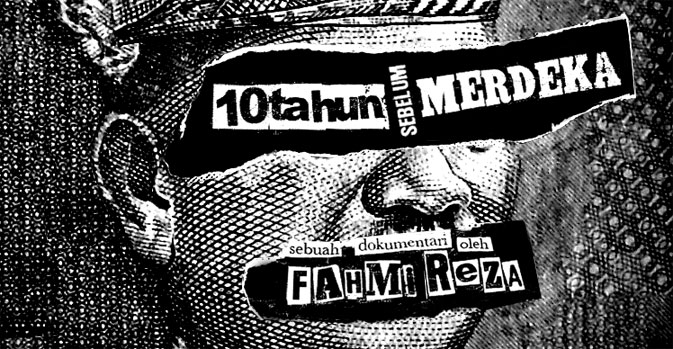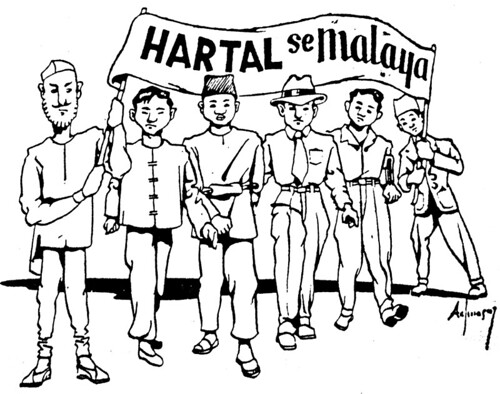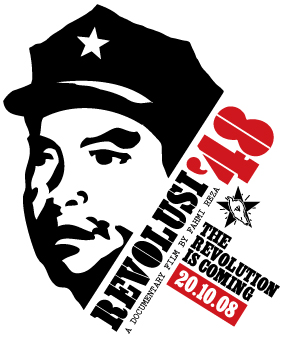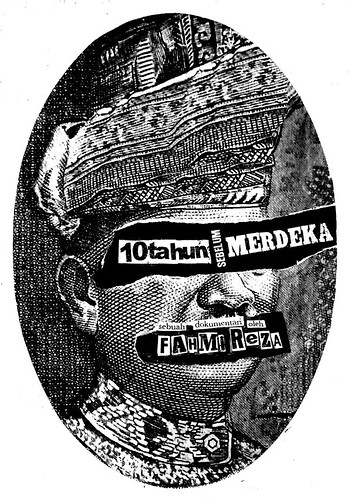( Ini artikel asal yang ditulis oleh Zeeneeshri sebelum ia diedit (lihat post sebelum ini) untuk akhbar New Sunday Times, 16 Sept 2007)
THE YEARS BEFORE MERDEKA (Unedited)
by R. Zeeneeshri
IN 1947, Malaya and Singapore witnessed the first political action that united all the races - the hartal. R. ZEENEESHRI speaks to a new filmmaker who revisits this turbulent era.
The years before Merdeka, a postwar era of struggle in identity, may be foggy in the minds of most of us.
"What we know comes from history books, with no form of understanding, just memorising facts," says Fahmi Reza, 30.
"Those years, some feel, are best left forgotten, overshadowed and ignored," he says. See a trailer of his documentary, Sepuluh Tahun Sebelum Merdeka, at www.10tahun.blogspot.com
"It's not just about that single moment when Tunku Abdul Rahman shouted 'Merdeka' seven times. It's not about that gist of hope that some admired from a distance, no matter how ideal and historical that moment was."
The fight for independence was a most complicated process, clashing different elements or ideas that led to the creation of a modern nation. Many tales have slipped under the radar, especially one such as the hartal.
First used by MK Gandhi during the Indian Independence Movement, the hartal is a mass protest often involving a total shutdown of workplaces, offices and shops. It is a mode of appealing to the sympathies of a government to change an unpopular or unacceptable decision.
Some call it a period of dissolution, when the British paid no attention to what was clearly a cry from the people. Self-taught non-commercial freelance graphic designer Fahmi is documenting these unforgotten tales, people and visions.
A winner of the Freedom FilmFest 07 (as part of its 50th Merdeka: The Untold Human Rights Story theme), Fahmi received a RM5,000 grant to make the film.
His 35-minute visual compiles events that led to the hartal, mainly the realization of an independent Malaya and the publication of a People’s Constitution drafted by Putera-AMJCA (Pusat Tenaga Rakyat-All Malayan Council of Joint Action), an alternative constitution to challenge the Federation Constitution.
“I’ve always had an interest in History, but not during school days. I got interested in memoirs and somehow stumbled into works by left wing member,” says Fahmi, readjusting his widely brimmed spectacle frames.
“Their struggle and how they were ignored and some even arrested excited me and since then, I had always wanted to produce a documentary based on them."
He did research and travelled to talk to octogenarians about events that existed then. Most of the grant money went to transportation, food and accommodation.
"But it was all worth it, as not much attention was paid to the late 1940s. These exciting years laid the groundwork for our independence."
“It was a period of intense political activity, in the vacuum after the Japanese surrender, which led to independence being declared in countries like Indonesia and Vietnam.”
Running his fingers through his shoulder length almost-straight hair, Fahmi says it was a time when people also realized that they could do good even without the British.
“They were in a comfort-zone before the war. They knew less than to go against the British even in their own land. It became a British-dependant way of life.
“That was until the Japanese took over and they realized that they did good even without the British. Some began to think beyond, towards neighboring country, Indonesia, where President Sukarno fought and won independence for the country.
“They began to think of freedom, a right to own one’s land. And that’s when the political front began to grow.”
Putera-AMJCA was formed, an alliance of Malay nationalist groups, front parties of the Communist Party of Malaya (CPM), trade unions and even the fledgling MIC and future MCA leader Tun Tan Cheng Lock.
“Looking back at the proposed constitution for a secular, multi-racial nation, I’m surprised at how progressive the thinking was.”
Fahmi says it pushed for equal citizenship rights for all who considered Malaya their permanent home, regardless of race or place of birth.
Another example of progressive thinking for those times was the provision for a Council of Races comprising two representatives of every race, including minorities, to ensure laws did not discriminate.
Given that 60 years have passed since all these events, a vast majority of the people involved have died. Still, Fahmi managed to interview a number of veterans from organisations that belonged to the Putera-AMJCA coalition.
He tapped the memories of significant people like Lim Kean Chye, founder member of the Malayan Democratic Union; Hashim Said, head of an Angkatan Pemuda Insaf (API) division; Majid Salleh, a labour leader who led the Johor State Federation of Trade Unions and who was also a member of Partai Kebangsaan Melayu Malaya (PKMM); and Zainuddin Andika and Yahya Nassim, both also PKMM members.
Lim and Yahya, are both 88 years of age while the others are not much younger – all eager to tell their side of the story, having waited decades.
“It was hard to find them, to talk to them and gain their trust. Many are very cautious and don’t like to talk about that time because it brings up unhappy memories and dashed hopes. Still, while it’s true that after many years people are vague about details, I felt it was very important that we talked to people who were actually there.”
Fahmi supplemented his interviews with documents from the National Archives and looked up newspapers of the time, like the Straits Echo, Malay Tribune, Utusan and Straits Times.
“I got my friends to help me out on a voluntary basis for the scenes that I shot, especially in handling the camera while interview.
“When they heard about my plan on the documentary, they all wanted in.”
Ironically, the very efficiency of the general strike of 1947 signalled the beginning of the end of this exciting period in Malayan history.
“It was the beginning of a more revolutionary and activist way of life. A life filled with freedom, but sad to say, it was short-lived.
“Just when things started to get juicy, the British slammed them, like a fly caught between a clap.
“But when you analyze the Putera-AMJC loss, what you see was a chance to win, they had the people behind them, and they had the intellect and the drive. They also had the constitution.”
Fahmi realises that revisiting the past can often re-open old wounds. "But there is nothing controversial about this documentary. It is the truth. All this information is out there, in texts, in memoirs. The only reason I made it on film was because we now live in a visual-generation."
“If you dig deeper, the people on the left wing were mostly the people that mattered, the people of grassroots level. The ones on the right were mainly the ‘bangsawan’, people with status. Now, do you think they would have wanted to give up their comfort for fair game? The civilians suffer the most”
“But, this documentary doesn’t deal with that chapter. This is a movie of non-violent political struggle of the underdogs for a better tomorrow.”
Isnin, September 17, 2007
Artikel asal untuk akhbar New Sunday Times, 16 Sept 2007
Dicatat oleh
Fahmi Reza
di
3:00 PTG
![]()
Kategori: Liputan Media
Langgan:
Catat Ulasan (Atom)








Tiada ulasan:
Catat Ulasan